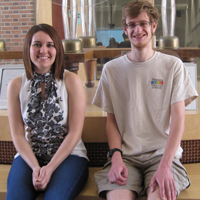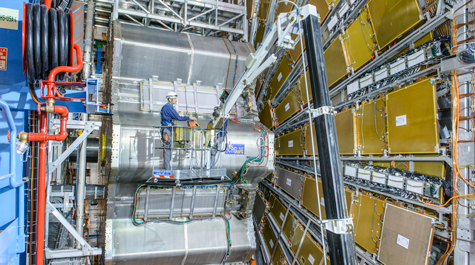Back from a summer at the home of the Large Hadron Collider
Rachel Hyneman and Will Bergan began each work day this past summer with a biometric iris scan. Once their identities were confirmed, they joined several thousand other particle physicists reporting for work at what might be the most interesting job in the world—the home of the Large Hadron Collider.
“When it’s on, you don’t want to be down there,” said Hyneman. “Down there” is a collection of particle accelerators, whose function is blasting particles to create collisions at extreme speeds. The iris scans and a host of other safety measures are all part of the job at CERN, one of the foremost physics facilities in the world, where researchers are tackling problems such as the search for dark matter and discovering extra dimensions.
The highly selective Research Experience for Undergraduates (REU) program at CERN, funded by the National Science Foundation, brought 15 undergraduate physicists from the U.S. to join 200 other students from all over the world to the facility best known for its groundbreaking discoveries on the “God particle,” the Higgs boson. Out of the 15 undergraduates chosen to participate from the United States, two—Hyneman and Bergan—hail from William & Mary’s very own physics department.
Wouter Deconinck, assistant professor of physics at William & Mary, says the opportunity to do research at CERN, near Geneva, Switzerland, is very highly regarded in the particle physics world.
“If you’re thinking of one physics lab, that’s the lab you would think of,” Deconinck said. “CERN is the place where the World Wide Web was invented and the center of where everything in science connects.”
 Students chosen for the CERN REU are assigned a project matching their interests. Once placed in their research interest, they have some of the brightest minds in physics to call their mentors. Hyneman ’15 worked on a hardware-based project, where she was tasked with upgrading the electronics in the famous ATLAS detector. Bergan ’15 studied the strong force on the ALICE detector, another of four detectors on CERN’s Large Hadron Collider.
Students chosen for the CERN REU are assigned a project matching their interests. Once placed in their research interest, they have some of the brightest minds in physics to call their mentors. Hyneman ’15 worked on a hardware-based project, where she was tasked with upgrading the electronics in the famous ATLAS detector. Bergan ’15 studied the strong force on the ALICE detector, another of four detectors on CERN’s Large Hadron Collider.
Hyneman’s main role was to check the electronics and time responses for new discriminators on the ATLAS detector. She explained that the ATLAS detector is a general purpose detector on the Large Hadron Collider, detecting the collisions of different particles and collecting data on the behavior of these particles.
“Different particles have different signatures that you can predict theoretically,” Hyneman explained. “The idea is that we want to know more about the fundamentals of the universe and that increased understanding allows us to do a lot of things.”
Bergan’s research was to understand more about the strong force during heavy ion collisions, which is when particles collide and break. Understanding the strong force gives scientists a better picture of quarks and gluons, the smallest components of the nucleus of an atom, as the strong force is what holds them together.
“It’s hard to study computationally because the gluons are interacting with each other and then they’re breaking into quarks and combining and it’s just a whole mess,” said Bergan.
Bergan used his experience in coding to work on the time-of-flight detector, essentially a giant stopwatch, using ALICE’s own programming software to better understand its efficiency.
Hyneman and Bergan credit much of their CERN success to the research opportunities and labs they were able to participate in through their coursework at William & Mary. Deconinck pointed out that the undergraduate physics program at William & Mary has a tradition of having students be involved in research through and outside of their regular coursework.
“Because of these research experiences at William & Mary, they become better candidates and are better suited for these top research programs,” said Deconinck.
Both students plan on pursuing careers in particle physics following their experience at CERN, and hope to continue to utilize the skills they learned with their ongoing research and coursework at William & Mary.
Other notable summer internships in physics
• Eve Chase ’16: gravitational wave detection from compact binary star coalescences at CNRS—Laboratoire Astroparticule et Cosmologie, Paris, France.
• Chris Haufe ’15: simulation of high energy cosmic ray radio emissions at Karlsruher Institut für Technologie, Karlsruhe, Germany
• Emma Pierce ’16: acoustics and sound projectors research at Naval Research Lab (NRL) through Naval Research Enterprise Internship Program (NREIP).
• Melissa Guidry ’17: single-photon detector for biomolecule detection at National Institute of Standards and Technology (NIST) through Summer Undergraduate Research Fellowship (SURF).
 Skip to main content
Skip to main content

